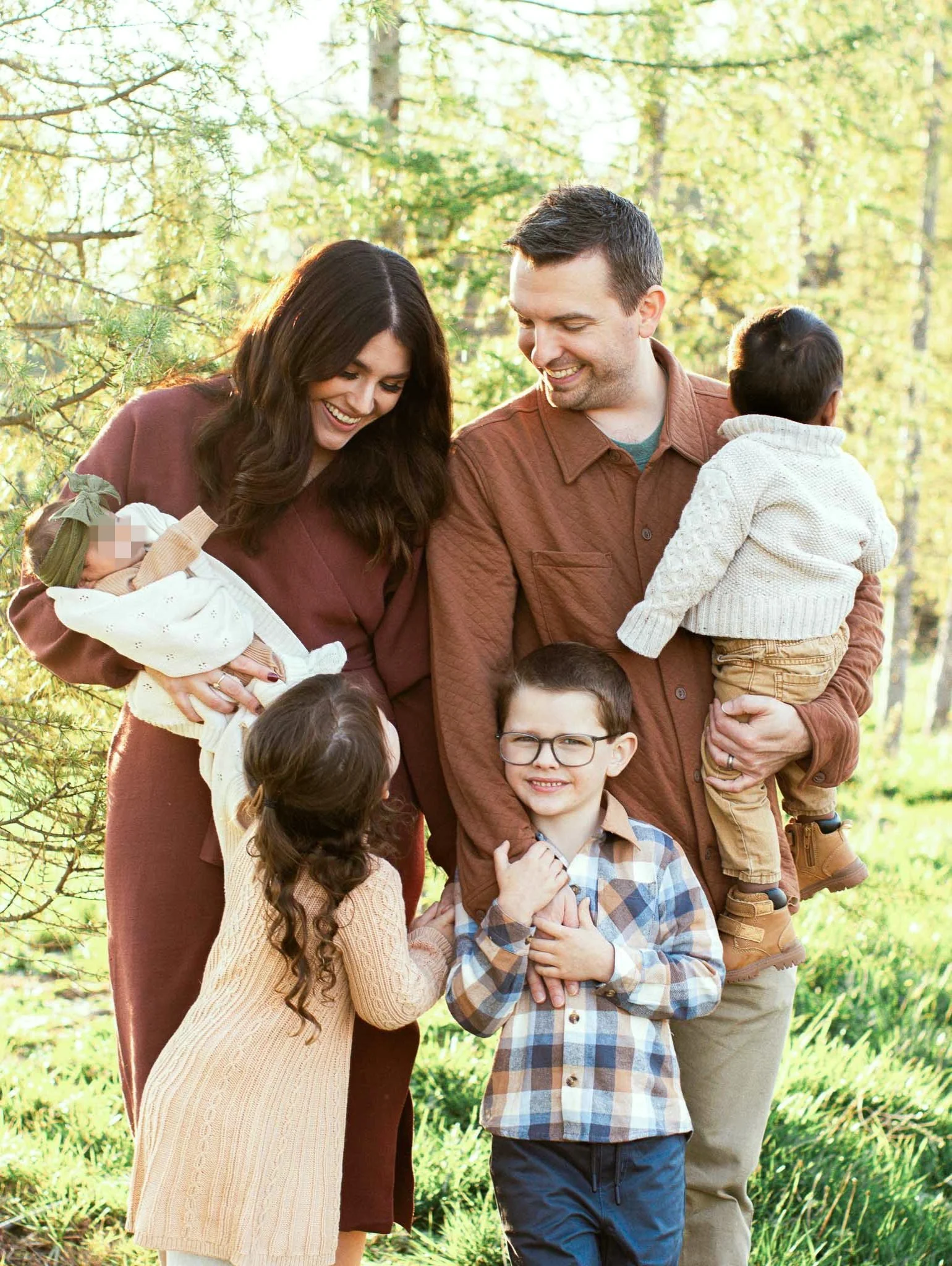-
FOSTER CARE
Foster parents who support the restoration of families are desperately needed. We can help close the gap between the number of kids in foster care and the number of foster parents.
-
FOSTER TO ADOPT
There are currently 120,000 children in the U.S. whose parental rights have been revoked and are legally free for adoption. These children are searching for permanent, loving families.
-
DOMESTIC ADOPTION
The care of vulnerable children and families can include many paths of adoption. Different types of domestic adoption include embryo, special needs and infant.

-
“Foster care is family-based care – at least that is the ideal. It is the temporary placement of children and youth outside of their own homes in order to protect them. Foster care gives parents time to learn skills to become the parents their children need them to be.” - American Kids Belong
-
“Currently, there are over 400,000 kids in foster care. (More than 100,000 are waiting for permanent adoptive families.) There is a perpetual gap between the number of kids in foster care and the number of foster parents.” - American Kids Belong
-
“Kids in foster care often are moved from one temporary setting to another. Frequent moves make it difficult for kids to concentrate on school, maintain friendships and family relationships, or begin the healing journey from the trauma that led to them being placed in foster care. Many times when foster families cannot be found, kids will be placed in group facilities or residential treatment centers. Research shows that living long term in group homes deprives kids of the opportunity to experience the stability, support and love of a family, where they can develop practical life skills, learn to build trusted bonds with parents and other family members, and have a support network of trusted adults who will care for them now and in the future.” - American Kids Belong
-
Item description“Typically, reunification begins with supervised visits (once or twice a week for an hour or so), between kids and their bio parents. As parents progress toward the goals of their court-defined treatment plans, the reunification process progresses to include unsupervised visits, overnight visits and weekend visits. Once kids return home, bio parents work with a social worker who provides in-home services and additional support to help the parents and kids make a smooth transition.” - American Kids Belong
-
“If a child cannot be safely reunited within a certain period of time (usually 12 to 18 months), the law requires that another permanent (adoptive) family be found for the child. The foster family is usually prioritized to adopt.” - American Kids Belong
-
“Foster and adoptive families need lots of support. You can offer respite care, babysitting, meals, transportation, etc. You can get your business to provide discounts, or you can get your faith community involved in supporting families. You also can become an advocate for children in foster care, like a CASA, a Court Appointed Special Advocate. CASA volunteers are sworn officers of the court, appointed by a juvenile-court judge to advocate for kids in foster care as a result of abuse or neglect.” - American Kids Belong
-
You can get licensed directly through your state’s Department of Child, Youth and Family Services (DCYF) or a private agency. We chose to work with a non profit agency to get our license for additional support. A google search will provide contact information for agency options and DCYF office in your county.
-
Our personal licensing process took three months, but it can take up to six months. Completing a home study takes 120 days on average. The time frame depends on many factors including the licensor and the family’s availability, engagement and collaboration.
-
“The "home study" is both an assessment process and report that everyone must complete to become a foster parent. The goal of the home study is to assess a family’s ability to provide a safe and healthy environment for young people experiencing foster care. The family’s licensor looks at the family’s individual and shared background in many areas that include, but are not limited to: Parenting experiences, Relationships, Support systems. Finances and Home environment.” - Washington DCYF
-
There is no fee to get your foster license through an agency or DCYF. However, there can be some expenses to get your house ready to pass the safety inspection. Once you receive a foster placement, DCYF provides families with reimbursement for foster care using standard rates that reflect the child's age and needs. The state also pays for childcare for working parents. In addition, there are many non profit organizations that can help provide items needed for children in foster care.
-
Getting attached is the point. The very thing children need to heal from trauma is a safe, stable attachment to a loving adult. We guard our hearts by taking captive negative thoughts about the system, birth families or the case outcome. We do not plan for a long term future with the children in our care. Instead, we thank God for every day we get to spend with them and trust him with the outcome of each case.
-
The goal of foster care is reunification and restoration of families. However, this is not always safe and possible. The second goal is to establish kinship care with a relative or close friend of the family of origin. When this is not possible, case plans can include adoption or permanent guardianship.
There are currently over 100,000 children in the U.S. who are legally free for adoption in the foster system. These children’s parental rights have been revoked and they have no options for kinship care. Social workers in every state are actively looking for adoptive families for these children. Organizations like American Kids Belong, Adopt.org, and Northwest Adoption Exchange provide information on legally free children and the process of Foster Adoption.
-
“Just under half of kids spend less than a year in foster care. Nearly 40 percent of kids spend one to three years in the foster-care system. Length of stay varies according to the circumstances of both the kids and families.” - American Kids Belong
Foster parents are able to choose to provide respite, short term or long term care. Many factors can cause the court to order a change to the case plan that can include the immediate moving of a child to another home.
-
Respite care provides short-term relief for primary caregivers. It can be arranged for just an afternoon or for several days or weeks. As a respite care provider, you get to choose how often you open your home and who you provide care for. Respite parents also receive a stipend for their time.
“Respite providers receive the same training and certification as foster parents and are often in high demand as there are many more foster parents than there are respite providers! Many respite families also get the opportunity to provide other supports for that youth and family as they build a relationship and become part of the foster family’s community long-term.” - Hopes Promise
-
“Foster parents, with the help of their licensor, determine how many children, what ages, and what gender they will be licensed for. Families are able to choose what developmental stages work best for their family and home environment. Families are able to note their preference for children they wish to have placed in their care. This is taken into consideration during the home study process and the licensor makes the final approval based on physical space available, meeting the licensing requirements for different age ranges, parenting skill level, and experience.” - Washington DCYF
-
“In general, foster parents are provided with detailed information, prior to placement, to help inform their decision about whether or not they are able to meet the child’s needs. Foster parents are encouraged to ask questions where they need more information. It is always okay to ask more questions and take time to gather more information. You will also receive the Child Information and Placement Referral form (CIPR). Often, DCYF does not have a lot of information about children who are new to care.” - Washington DCYF
-
Travel is allowed, but every state has different rules. In Washington for example, any travel beyond 72 hours or out-of-country requires prior approval from the child’s caseworker.
-
One parent is required to complete Caregiver Core training and both parents are required to complete CPR training. You will receive training during the licensing process on appropriate forms of discipline and trauma informed care. There is also ongoing training support once you become licensed.
Field Guide for Families offers identity coaching for foster and adoptive parents. We are not adoption or foster care consultants. We help families prepare their hearts spiritually and emotionally to care for vulnerable families.
Field Questions | Foster Care
Field Questions | Adoption
-
The testimonies are endless of God’s faithfulness to provide for adoptions. There are also practical means including adoption grants, no interest/low interest adoption loans, the adoption tax credit, employer adoption benefits and fundraising. Julie Gumm’s book, Adopt Without Debt offers creative ways to fund adoptions.
-
We love Christian Adoption Consultants high ethical standard for every agency they partner with. Their multi-agency approach significantly decreases the wait time for prospective adoptive parents. We felt the wisdom, support and resources provided to us by our consultant was invaluable.
-
Despite our efforts to work with the most ethical agencies, we still experienced unethical practices from multiple agencies. Unfortunately, the current adoption industry is run like a business and unethical practices are not uncommon. We asked a lot of questions before choosing which agencies to work with. Any signs of coercion of expectant mothers was unacceptable for us. We looked for agencies that fully support birth mothers and provide them with free counseling for life. We also tried to ensure that the agencies we work with still support the mothers who make an adoption plan but later choose to parent.
-
“There are two stages in the adoption process: pre-placement and post-placement. Placement is when the child enters your home, pre-placement describes the time before and post-placement the time after. There is a pre-placement waiting period for all adoptions. The time frame, like the cost, varies with the type of child being adopted. With a completed homestudy in hand, the process to adopt a child with special needs can often proceed quickly and be completed within a few months. The wait is typically between two and seven years for a healthy infant.
After placement, your agency will have to supervise your family for a legally-mandated length of time before finalization can occur. Typically this post-placement time period will be no less than six months from the time of placement.” (Adopt.org)
-
“Yes. The Adoption and Safe Families Act (ASFA), passed in 1998, requires state agencies to speed up a child's move from foster care to adoption by establishing time frames for permanency planning and guidelines for when a child must be legally freed for adoption. The law also removes geographic barriers to adoption by requiring that states not delay or deny a placement if an approved family is available outside the state.” - Adopt.org
-
“Foster care is meant to be temporary shelter for a child; generally the plan is for the child to return to the parents when they are able to provide care. If that fails, the child is made available for adoption.
Foster parents may be able to adopt the child in their care if the child becomes available, through a foster-adopt program with their agency. In fact, most adoptions in the United States are by children's foster parents. Beginning as a foster parent is also one way that you may be able to adopt a healthy infant or toddler. But you are not required to be a foster parent in order to adopt.
While some agencies approve a family simultaneously for both foster care and adoption, a foster care homestudy and an adoption homestudy are not always interchangeable. If you are thinking about foster-adoption, it is important to inquire how an agency handles this.” -Adopt.org
-
“During the preparation for adoption, as you complete your home study, an agency social worker counsels you and provides information and support. Sometimes social workers will refer families to special interest groups for a particular child's needs. They may also provide information on adoptive parent support groups, a valuable resource.
Adopt.orgFamily preparation classes are offered by some agencies and required by others.” -Adopt.org




